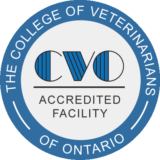UGVS Newsletter – October 2023
Whether to Water the Calves
By: Dr. Mike Scolaro
As a part of our commitment to growing as a clinic to serve your evolving needs, Dr Mike Scolaro went to The American Association of Bovine Practitioners conference in Milwaukee WI and sat in on talks from global experts in all things cattle. There will be a series of posts to discuss some of the key take homes and our first one is all about water!
Even though pre-weaned calves primarily rely on a food source that contains a significant amount of water, it’s essential to understand that they still need additional water to thrive. You might be tempted to dismiss this idea, saying, “Mike, I already have my hands full with calf care, and my calves seem fine as they are.” That’s completely understandable! Farm life is incredibly busy but let me provide you with some evidence of why water supplementation is crucial.

Every calf benefits from having access to water. Sick calves will drink more water, and healthy calves need it to facilitate starter intake. In fact, limiting water can reduce starter ration intake! To facilitate 1 kg of starter intake, we need to provide 4 liters of water. It’s also important to note that water has no calories, so allowing water intake won’t reduce the calf’s appetite for milk. By simply providing a pail or trough, you can enhance your herd’s growth potential!
My challenge to you is simple—Give it a try! For a week, after feeding milk, provide a bucket with a few litres of water to each calf (bonus if it’s not directly next to the starter pail, cross contamination can cause bacteria buildup in a hurry) and pay attention to how full it is at next feeding. Wintertime can be a challenge, especially in hutches for the provision of water but the effort will not go unrewarded! For those of you with waterers, calves need 2” of waterer length to make sure we aren’t restricting water. Equally important is the height of the waterer, which should not exceed 29” for newborns and can go higher as they age.
Recommendations can be found at https://thedairylandinitiative.vetmed.wisc.edu/home/housing-module/replacement-housing/feed-and-water-space-requirements/ . At the end of the day, a few drops in the bucket can make a world of difference to calf health and the development of your herd’s future.
Due to a global shortage of Lurocaine/Lidocaine products we have been unable to source Lurocaine from our usual supplier. We have researched and found an additional outside source but with this there is a cost increase. For us to be able to continue our dehorning services and prevent the need to dehorn at an older age (costing more to you and worse welfare on the calf) there will be a temporary increase to our dehorning pricing to account for the increase in pricing of Lurocaine. We have been forced to temporarily add $1.50 per dehorning due to cover the cost of the dehorning freezing. Once we have our normal product back the price will revert to the original pricing.
|


 Cyber Security
Cyber Security the less. Other potential disasters include shutting off fans in poultry barns, disabling online generators, and anything that has a web access on the farm.
the less. Other potential disasters include shutting off fans in poultry barns, disabling online generators, and anything that has a web access on the farm.


